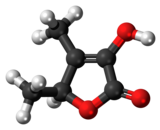Sotolon

| |

| |
| Names | |
|---|---|
| IUPAC name
3-Hydroxy-4,5-dimethylfuran-2(5H)-one
| |
| Other names
Sotolone
Caramel furanone Sugar lactone Fenugreek lactone | |
| Identifiers | |
3D model (JSmol)
|
|
| ECHA InfoCard | 100.044.655 |
PubChem CID
|
|
CompTox Dashboard (EPA)
|
|
| |
| Properties | |
| C6H8O3 | |
| Molar mass | 128.127 g·mol−1 |
| Density | 1.049 g/cm3 |
| Melting point | 26 to 29 °C (79 to 84 °F; 299 to 302 K) |
| Boiling point | 184 °C (363 °F; 457 K) |
Except where otherwise noted, data are given for materials in their standard state (at 25 °C [77 °F], 100 kPa).
| |
Sotolon (also known as sotolone) is a lactone and an extremely powerful aroma compound, with the typical smell of fenugreek or curry at high concentrations and maple syrup, caramel, or burnt sugar at lower concentrations. Sotolon is the major aroma and flavor component of fenugreek seed and lovage,[1] and is one of several aromatic and flavor components of artificial maple syrup.[2] It is also present in molasses, aged rum, aged sake and white wine, flor sherry, roast tobacco,[3] and dried fruiting bodies of the mushroom Lactarius helvus.[4] Sotolon can pass through the body relatively unchanged, and consumption of foods high in sotolon, such as fenugreek, can impart a maple syrup aroma to one's sweat and urine. In some individuals with the genetic disorder maple syrup urine disease, it is spontaneously produced in their bodies and excreted in their urine, leading to the disease's characteristic smell.[5]
This molecule is thought to be responsible for the mysterious maple syrup smell that has occasionally wafted over Manhattan since 2005.[6]
Sotolon was first isolated in 1975 from the herb fenugreek.[7] The compound was named in 1980 when it was found to be responsible for the flavor of raw cane sugar: soto- means "raw sugar" in Japanese and -olon signifies that the molecule is an enol lactone.[8]
French vin jaune
Vin jaune is marked by the formation of sotolon from α-ketobutyric acid.[9][10]
See also
- Candy cap (Lactarius mushroom species whose maple syrup aroma derives from quabalactone III, which hydrolyzes into sotolon)
References
- ^ Imre Blank; Peter Schieberle (1993). "Analysis of the seasoning-like flavour substances of a commercial lovage extract" (abstract). Flavour and Fragrance Journal. 8 (4): 191–195. doi:10.1002/ffj.2730080405.
- ^ "Caractéristiques chimiques et nutritives du sirop d'érable" (PDF) (in French). Centre de recherche, de développement et de transfert technologique acéricole. March 1994.
{{cite journal}}: Cite journal requires|journal=(help) - ^ Sigma-Aldrich
- ^ Sylvie Rapior, Françoise Fons; Jean-Marie Bessièreb (2000). "The fenugreek odor of Lactarius helvus" (abstract). Mycologia. 92 (2). Mycological Society of America: 305–308. doi:10.2307/3761565. JSTOR 3761565.
{{cite journal}}: Unknown parameter|lastauthoramp=ignored (|name-list-style=suggested) (help) - ^ F. Podebrad, M. Heil, S. Reichert1, A. Mosandl, A. C. Sewell and H. Böhles (1999). "4,5-Dimethyl-3-hydroxy-2(5H)-furanone (sotolone) — The odour of maple syrup urine disease". Journal of Inherited Metabolic Disease. 22 (2): 107–114. doi:10.1023/A:1005433516026. PMID 10234605.
{{cite journal}}: CS1 maint: multiple names: authors list (link) CS1 maint: numeric names: authors list (link) - ^ John Matson (Feb 5, 2009). "Mystery of NYC maple syrup smell solved!". Scientific American News Blog.
{{cite web}}: Italic or bold markup not allowed in:|publisher=(help) - ^ F. Rijkens and H. Boelens (1975) "The future of aroma research," Proceedings of the International Symposium on Aroma Research, H. Maarse and P.J. Groenen, eds. (Wageningen, Netherlands: Pudoc, 1975), pp. 203-220.
- ^ Tokitomo, Yukiko; Kobayashi, Akio; Yamanishi, Tei; Muraki, Shigeru (1980) "Studies on the "sugary flavor" of raw cane sugar. III. Key compound of the sugary flavor," Proceedings of the Japan Academy, series B, 56 (7) : 457-462 ; see footnote on p. 457.
- ^ Thuy, Pham Thu; Elisabeth, Guichard; Pascal, Schlich; Claudine, Charpentier (1995). "Optimal Conditions for the Formation of Sotolon from α-Ketobutyric Acid in the French "Vin Jaune"". Journal of Agricultural and Food Chemistry. 43 (10): 2616. doi:10.1021/jf00058a012.
- ^ Guichard, E.; Pham, T. T.; Etievant, P. (1993). "Quantitative determination of sotolon in wines by high-performance liquid chromatography". Chromatographia. 37 (9–10): 539. doi:10.1007/BF02275793.
